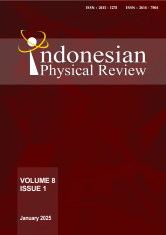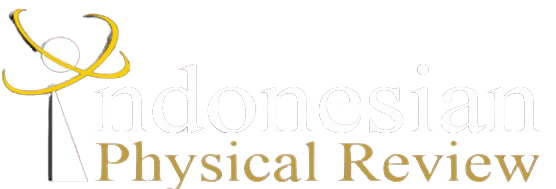MONTE CARLO ANALYSIS OF FETAL DOSE DISTRIBUTION IN PREGNANCY FOR DIFFERENT FETAL AGES, BEAM LOCATION, BEAM ENERGY, AND FIELD SIZES
DOI:
10.29303/ipr.v8i1.406Downloads
Abstract
Treatment with radiotherapy in pregnant women may occur due to some critical conditions. The dose given during the treatment process is not only received by the patient but can also be absorbed by the fetus which can affect its growth. Moreover, the radiation target is near the fetus such as the lung. This study aims to determine the dose distribution to the fetus with variations in fetal age (trimester 1, 2, and 3), beam energy, field size, and fetal distance to the target location (lung). The entire simulation utilized the Monte Carlo-based software EGSnrc-DOSXYZnrc which produced a 3-dimensional dose distribution on the virtual phantom. The simulated virtual phantom is a box with a size of 40×40×40 cm3 containing several materials, namely water, tissue, and lung. The size of the fetus is varied according to trimesters 1, 2, and 3. The beam is in the form of monoenergetic photons with energies of 3 MeV and 5 MeV emitted from above with a source to surface distance (SSD) of 48 cm. The field size was set at 5×5 cm2 and 8×8 cm2 on the phantom surface. The beam axis was located at a distance of 5 cm and 3 cm from the fetus. The results showed that the four variations performed affected the fetal dose, where the fetal dose increased considerably when the field size was enlarged and the beam axis was closer to the fetal position. The increase in fetal dose is also influenced by the increase in fetal age and beam energy. Meanwhile, the location of the beam below the lung causes an increased dose to the fetus due to the closer position of the beam to the fetus.
Keywords:
EGSnrc fetal dose Monte Carlo Method pregnancyReferences
O. D. Asmara, E. D. Tenda, G. Singh, C. W. Pitoyo, C. M. Rumende, W. Rajabto, N. R. Ananda, I. Trisnawati, E. Budiyono, H.F Thahadian, E. C. Boerma, A. Faisal, D. Hutagaol, W. Soeharto, F. Radityamurti, E. Marfiani, P. Z. Romadhon, F. N. Kholis, H. Suryadinata, A. Y. Soeroto, S. A. Gondhowiardjo, W. H. Geffen, “Lung Cancer in Indonesiaâ€, Journal of Thoracic Oncology, vol. 18, no. 9, pp. 1134 – 1145, June. 2023.
S. H. Bradley, M. P. T. Kennedy, R. D. Neal, “Recognising Lung Cancer in Primary Careâ€, Adv Ther, vol. 36, no. 1, pp. 19 – 30, 2019.
D. Palma, O Visser, F. J. Lagerwaard, J. Belderbos, B. J. Slotman, S. Senan, “Impact Of Introducing Stereotactic Lung Radiotherapy For Elderly Patients With Stage I Non-Small-Cell Lung Cancer: A Population-Based Time-Trend Analysisâ€, J Clin Oncol, vol. 28, no. 35, pp. 5153-9, Dec. 2010.
E. D. Brooks, B. Sun, L. Zhao, R. Komaki, Z. Liao, M. Jeter, “Stereotactic Ablative Radiation Therapy is Highly Safe and Effective for Elderly Patients with Early-stage Non-Small Cell Lung Cancerâ€, Int J Radiat Oncol Biol Phys, vol. 98, no. 4, pp. 900–907, Jul. 2017.
S. Senthi, F. J. Lagerwaard, C. J. Haasbeek, B. J. Slotman, S. Senan, “Patterns Of Disease Recurrence After Stereotactic Ablative Radiotherapy For Early Stage Non-Small-Cell Lung Cancer:A Retrospective Analysisâ€, Lancet Oncol, vol. 13, no. 8, pp. 802–9. Aug. 2012.
P. Iyengar, K. Westover, R. D. Timmerman, “Stereotactic Ablative Radiotherapy (SABR) For Non-Small Cell Lung Cancerâ€, Semin Respir Crit Care Med, vol. 34, no. 6, pp. 845–54, Dec. 2013.
K. Wang, J. E. Tepper, “Radiation Therapy-Associated Toxicity: Etiology, Management, And Preventionâ€. CA Cancer J Clin, vol. 71, no. 5, pp. 437–454, Jul. 2021.
S. Boussios, S. N. Han, R. Fruscio, M. J. Halaska, P. B. Ottevanger, F. A. Peccatori, L. Koubkova, N. Pavlidis, FAmant, “Lung Cancer in Pregnancy: Report of Nine Cases from An International Collaborative Studyâ€, Lung Cancer, vol. 82, no. 3, pp. 499-505, 2013.
H. B. Kal, H. Struikmans. “Radiotherapy During Pregnancy: Fact and Fictionâ€, Lancet Oncol, vol. 6, no. 5, pp. 328-333, May. 2005.
D. Pereg, G. Koren, M. Lishner, “Cancer in pregnancy: Gaps, challenges and solutionsâ€, Cancer Treatment Reviews, vol. 34, no. 4, pp. 302-312, Jun. 2008.
S. Y. Woo, L. M. Fuller, J. H. Cundiff, M. L. Bondy, F. B. Hagemeister, P. McLaughlin, W. S. Velasquez, F. Swan, M. A. Rodriguez, F. Cabanillas, P. K. Allen, R. J. Carpenter, “Radiotherapy During Pregnancy for Clinical Stages IA–IIA Hodgkin's Diseaseâ€, Int J Radiat Oncol Biol Phys, vol. 23, no. 2, pp. 407-412, 1992.
E. Angel, C. V. Wellnitz, M. M. Goodsitt, N. Yaghmai, J. J. DeMarco, C. H. Cagnon, J. W. Sayre, D. D. Cody, D. M. Stevens, A. N. Primak, C. H. McCollough, M. F. McNitt-Gray, “Radiation Dose to The Fetus for Pregnant Patients Undergoing Multidetector CT Imaging: Monte Carlo Simulations Estimating Fetal Dose for A Range of Gestational Age and Patient Sizeâ€, Radiology, vol. 249, no. 1, pp. 220-7, Oct. 2008.
M. Mazonakis, A. Tzedakis, J. Damilakis J, “Monte Carlo Simulation of Radiotherapy for Breast Cancer in Pregnant Patients: How to Reduce the Radiation Dose and Risks to Fetusâ€, Radiatation Protection Dosimetry, vol. 175, no. 1, pp. 10-16, Sep. 2016.
M. Aabid, S. Semghouli, B. Amaoui, A. Choukri. “Evaluation Of Fetal Dose During Pelvimetry CT Scan Procedure by Monte Carlo Using GATEâ€, Radiation Physics and Chemistry, vol. 210, pp. 111042, Sep. 2023.
R. Mohan, J. Antolak, “Monte Carlo Techniques Should Replace Analytical Methods for Estimating Dose Distributions in Radiotherapy Treatment Planningâ€, Med. Phys, vol. 28, no. 2, pp. 123-126, Feb. 2001.
I. F. Maulana, S. Yani, T. Sumaryada, M. F. Rhani, F. Haryanto, “Commissioning of Elekta Infinityâ„¢ 6 MV flattening filter-free using Monte Carlo simulationâ€, Radiation Physics and Chemistry, vol. 210, pp. 11101, Sep. 2023.
S. Yani, Y. A. Noviantoro, M. F. Rhani, T. Sumaryada, F. Haryanto, “Verification Of 3D-CRT Dose Distribution in Arccheck Phantom Using Monte Carlo Codeâ€, Radiation Physics and Chemistry, vol. 210, pp. 111019, Sep. 2023.
M. S. Wyatt, L. F. Miller, "A comparison of Monte Carlo and model-based dose calculations in radiotherapy using MCNPTV", Nuclear Instruments and Methods in Physics Research Section A: Accelerators, Spectrometers, Detectors and Associated Equipment, vol. 562(2), pp. 1013-1016, 2006.
J. Park, C. Kung, "Monte Carlo Based Algorithms Are More Accurate for Dose Calculations in Radiotherapy", Biomedical Science and Engineering, vol. 2, no.2, pp. 40-41, 2014.
J. Wu, Y. Xie, Z. Ding, F. Li, L. Wang, "Monte Carlo study of TG-43 dosimetry parameters of GammaMed Plus high dose rate 192Ir brachytherapy source using TOPAS", J Appl Clin Med Phys, vol. 22, pp. 146-153, 2021.
L. Brualla, M. Rodriguez, J. Sempau, P. Andreo, “PENELOPE/PRIMO-Calculated Photon and Electron Spectra from Clinical Acceleratorsâ€, Radiat Oncol, vol. 14, no. 6, pp. 6, Jan. 2019.
Y. Benameur, M. Tahiri, M. Mkimel, R. E. Baydaoui, M. Najeh, S. Sahraoui, N. Benchekroun, M. Bougteb, B. E. Hariri, M. R. Mesradi, A. Hilali, E. M Saad, “Fetal Dose Estimation During Pregnancy Using Gate Monte Carlo Simulation: Application of Hodgkin’s Lymphoma Radiotherapyâ€, Radiation Protection Dosimetry, vol. 199, no. 7, pp. 581–587, May. 2023.
C. Geng, M. Moteabbed, J. Seco, Y. Gao, X, G. Xu, J. R. Méndez, B. Faddegon, H. Paganetti, “Dose Assessment for The Fetus Considering Scattered and Secondary Radiation from Photon and Proton Therapy When Treating a Brain Tumor Of The Motherâ€, Phy Med Biol, vol. 61, no. 2, pp. 683, Jan. 2016.
B. Walters, I. Kawrakow, D. W. O. Rogers, “DOSXYZnrc User’s Manualâ€, National Research Council of Canada, Ottawa, (Canada), 2023.
I. D. Nurhadi, R. Ramdani, F. Haryanto, Y. S. Perkasa, M. Sanjaya, “Analysis of Effect of Change Source to Surface Distance (SSD) and the Field Size to Distribution Dose Using Monte Carlo Method-EGSnrcâ€, Indonesian Journal of Physics, vol. 30, no. 1, pp. 14-17, Jul. 2019.
N. F. Nuzula, K. Adi, C. Anam, “Correction of 2D Isodose Curve on the Sloping Surface Using Tissue Air Ratio (TAR) Methodâ€, Jurnal Sains dan Matematika, vol. 23, no. 3, pp. 65-72, 2015.
R. Fardela, A. M. Putri, I. Andriani, F, Diyona, R. Analia, D. Mardiansyah, “Analysis of OAR Dose in Radiotherapy for Sinastra Breast Cancer at Universitas Andalas Hospitalâ€, Natural Science: Jurnal Penelitian Bidang IPA dan Pendidikan IPA, vol. 9, no. 2, pp. 112-123, Sep 2023.
D. Septhya, K. Rahayu, S. Rabbani, V. Fitria, Rahmaddeni, Y. Irawan, R. Hayami, “Implementation of Decision Tree Algorithm and Support Vector Machine for Lung Cancer Classificationâ€, MALCOM: Indonesian Journal of Machine Learning and Computer Science, vol. 3, no. 1, pp. 15-19, Apr 2023.
Z. R. Utami, Margono, Y. Kusmiyati, "Hubungan Hamil Usia Dini dengan Kejadian BBLR di Kecamatan Karangmojo Kabupaten Gunungkidul Tahun 2018", B.S. thesis, Dept. of Midwifery, Poltekkes Kemenkes Yogyakarta, Yogyakarta, 2020
License

This work is licensed under a Creative Commons Attribution-NonCommercial-ShareAlike 4.0 International License.
Authors who publish with Indonesian Physical Review Journal, agree to the following terms:
- Authors retain copyright and grant the journal right of first publication with the work simultaneously licensed under a Creative Commons Attribution-ShareAlike 4.0 International Licence (CC BY SA-4.0). This license allows authors to use all articles, data sets, graphics, and appendices in data mining applications, search engines, web sites, blogs, and other platforms by providing an appropriate reference. The journal allows the author(s) to hold the copyright without restrictions and will retain publishing rights without restrictions.
- Authors are able to enter into separate, additional contractual arrangements for the non-exclusive distribution of the journal's published version of the work (e.g., post it to an institutional repository or publish it in a book), with an acknowledgment of its initial publication in Indonesian Physical Review Journal.
- Authors are permitted and encouraged to post their work online (e.g., in institutional repositories or on their website) prior to and during the submission process, as it can lead to productive exchanges, as well as earlier and greater citation of published work (See The Effect of Open Access).





